This post may contain affiliate sales links. Please read my disclosure policy.
Making your own homemade Bone Broth is so easy and so affordable, you’ll wonder why you ever purchased the store bought stuff! Made with basically free ingredients, you’re just a few hours away from this nourishing pantry staple.
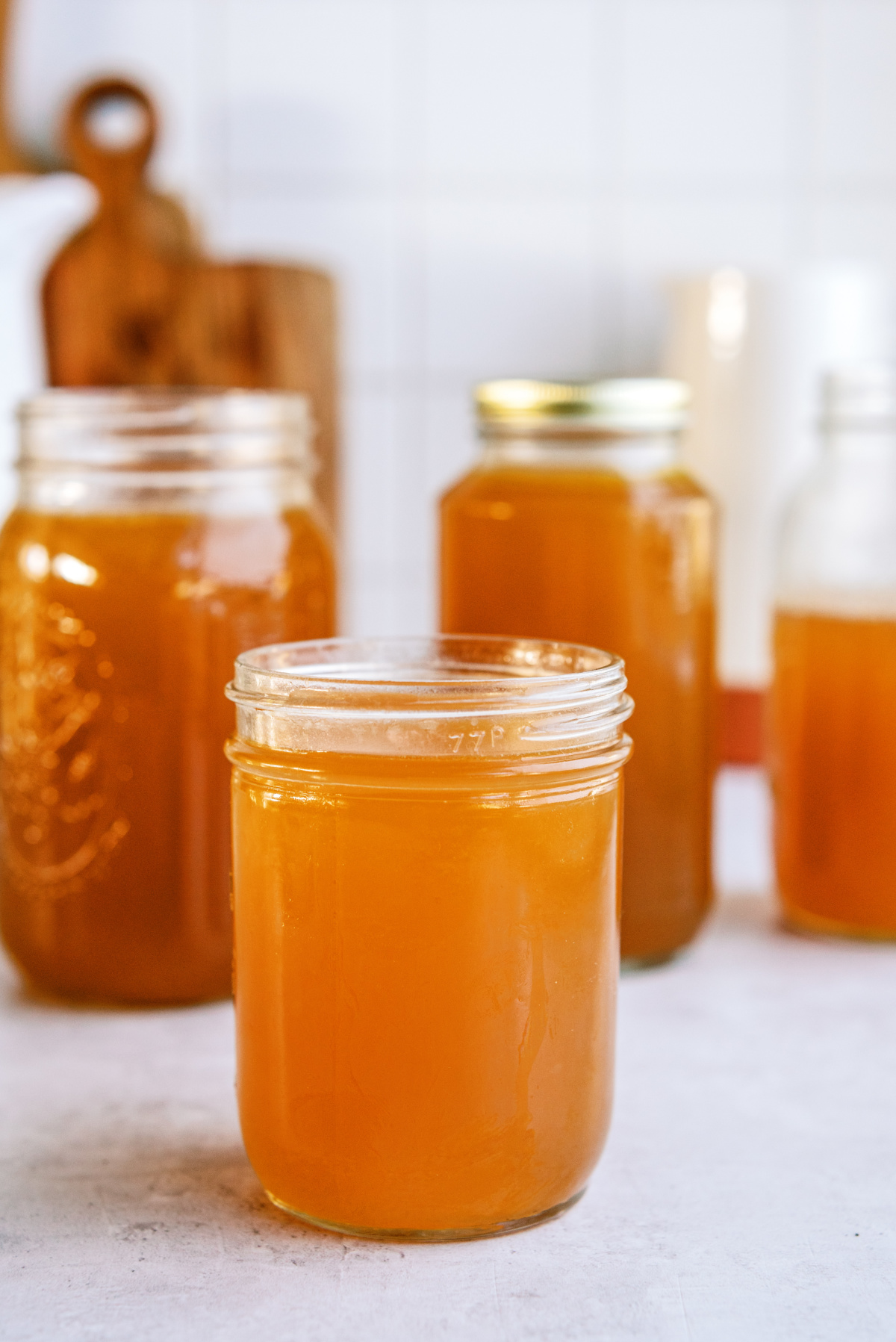
But First, What is Bone Broth?
Bone broth has really gained popularity in the last few years due to its numerous health benefits. The secret is out! Bone broth is so rich in nutrients and minerals like collagen, gelatin, and amino acids, which can help boost the immune system, among other things. Not to mention it’s absolutely delicious! There’s a reason mom makes chicken soup when you’re sick! I love a cup of bone broth first thing in the morning…it warms the soul!
Store-bought bone broth can get quite expensive…making your own bone broth at home is a simple process, and it can be a great way to use up leftover bones and raw vegetables.
Can I Use Any Type of Bones to Make Bone Broth?
Yes, you can use a variety of bones and marrow bones to make bone broth, including chicken, beef, lamb, pork, and more. Different types of bones will give the broth different flavors and nutrient profiles. The delicious bone marrow will melt in the broth and enhance the nutritional benefits…not to mention produce an amazing flavor.
What Kind of Scraps do I Save for Bone Broth?
I highly recommend keeping a bag or container in your freezer and save your kitchen scraps, bones whole chicken carcasses (like from a rotisserie chicken), etc. I keep mine in a freezer bag and constantly add to it as I cook meals. Not all vegetables work well in a broth, so I limit the scraps I save to just onion, shallot, leek, garlic, carrot, celery, and fresh herbs like parsley, oregano, thyme, etc. When a recipe calls for an onion, don’t throw the skins or root away…save it! Same with all the other vegetables and herbs I’ve listed. If you notice your celery getting a little limp, throw it in the freezer for your next batch of broth! Zero food waste! Other food scraps not listed here can be saved for a vegetable stock, but the ones in my recipe are best for a bone broth.
A Note on Chicken Feet
I love to include chicken feet in my homemade bone broth because they are rich in collagen. This protein breaks down during the simmering process to create a rich gelatin. I highly recommend adding these to your broth for that extra special gelatinous texture, not to mention the added health benefits (like supporting the connective tissues in the body).
What Does Adding Vinegar to Bone Broth do?
Vinegar is often added to bone broth because it helps extract the nutrients, minerals, and collagen from the bones and connective tissue. The acidity of the vinegar helps to break down the collagen and make it more bioavailable.
Should I Add Salt to my Bone Broth?
I do NOT add salt to my bone broth until I’m ready to use it as a soup or in a recipe. You are welcome to salt your bone broth as its cooking, but since I never know what recipe I will be using it for, I prefer to keep it unsalted until ready for use.
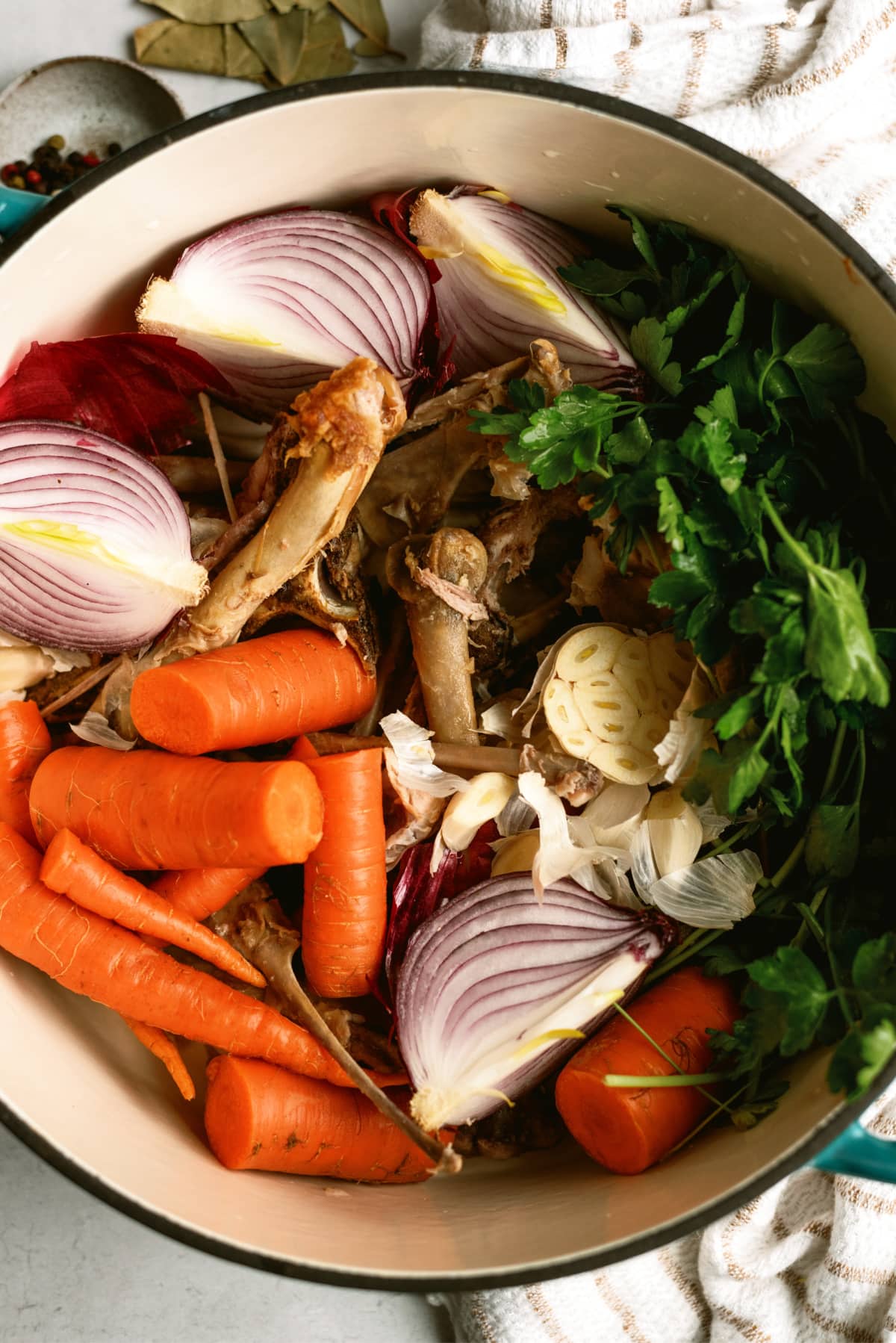
How to Make Homemade Bone Broth
This recipe is done by simmering on the stovetop, but I have included Instant Pot and Slow Cooker Instructions as well. For full recipe details, including ingredients I used, see the printable recipe card down below. Keep scrolling for slow cooker directions and also for those of you who like to use pressure cookers.
Prep Bones (if uncooked)
If bones are uncooked, place in a roasting pan with oil and roast on 425° F for 45 minutes or until well browned.
If bones are already cooked, simply place in a large stock pot.

Add Vegetables to Pot, Cover with Water, and Bring to a Boil
Add all vegetables, herbs/spices and vinegar to a pot and cover with filtered water. Feel free to experiment with different vegetables and spices to find the combination that you like best.
Bring to a boil, then reduce heat to a simmer.
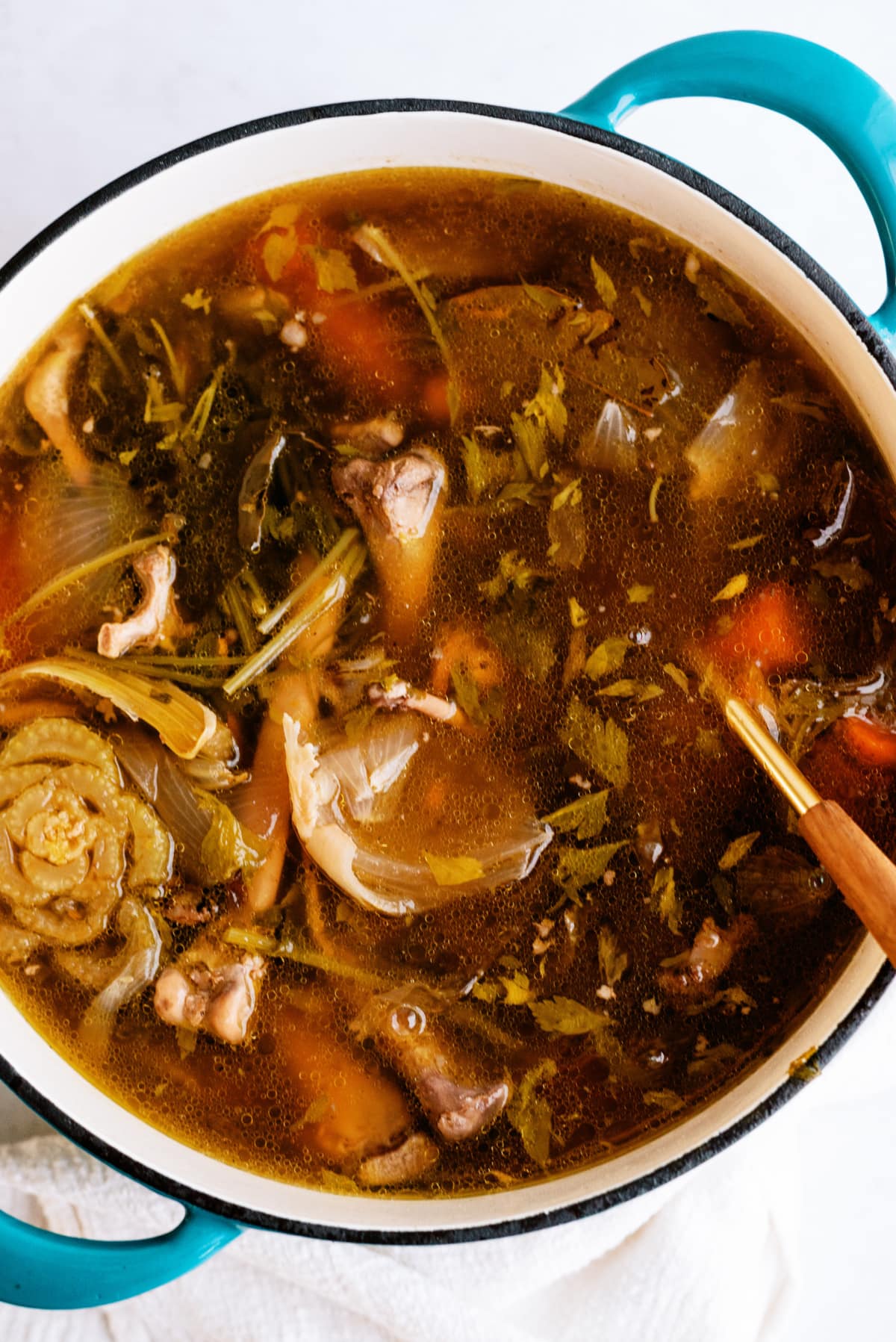
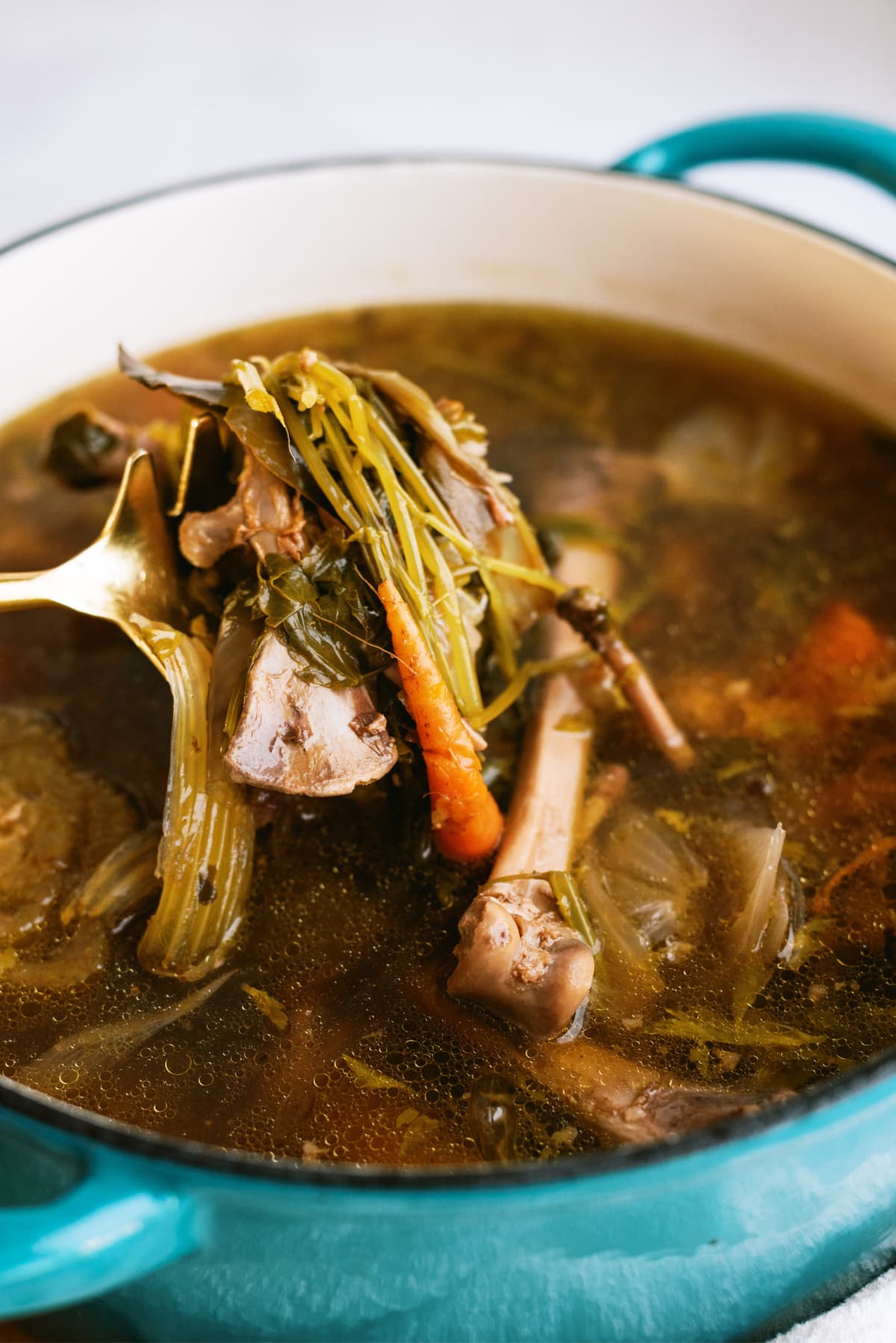
Simmer on Low
Simmer on low for anywhere from 24-48 hours. Some recipes say you must keep at a certain temperature to maintain the gelatin but I have found that just keeping it at a low simmer does the trick and the broth sets up quite well.
This can also be done in a slow cooker on low. See below for slow cooker and Instant Pot Directions.
How long should I simmer the broth for?
The longer you simmer the broth, the more flavorful and nutrient-dense it will become. I recommend simmering the broth for at least 12 hours, but you can simmer it for up to 48 hours for a more concentrated broth. Add more water as needed.
Drain Broth
Drain broth in a fine mesh strainer into a large bowl. Drain broth again into another large bowl with a flour sack towel to strain out all the impurities.
Optional: Before pouring into mason jars, you can use a fat separator to strain out fat before storing in your glass jars. The easiest way to strain extra fat though is to refrigerate and it will solidify at the top of the jar for easy removal. Use the fat for cooking!
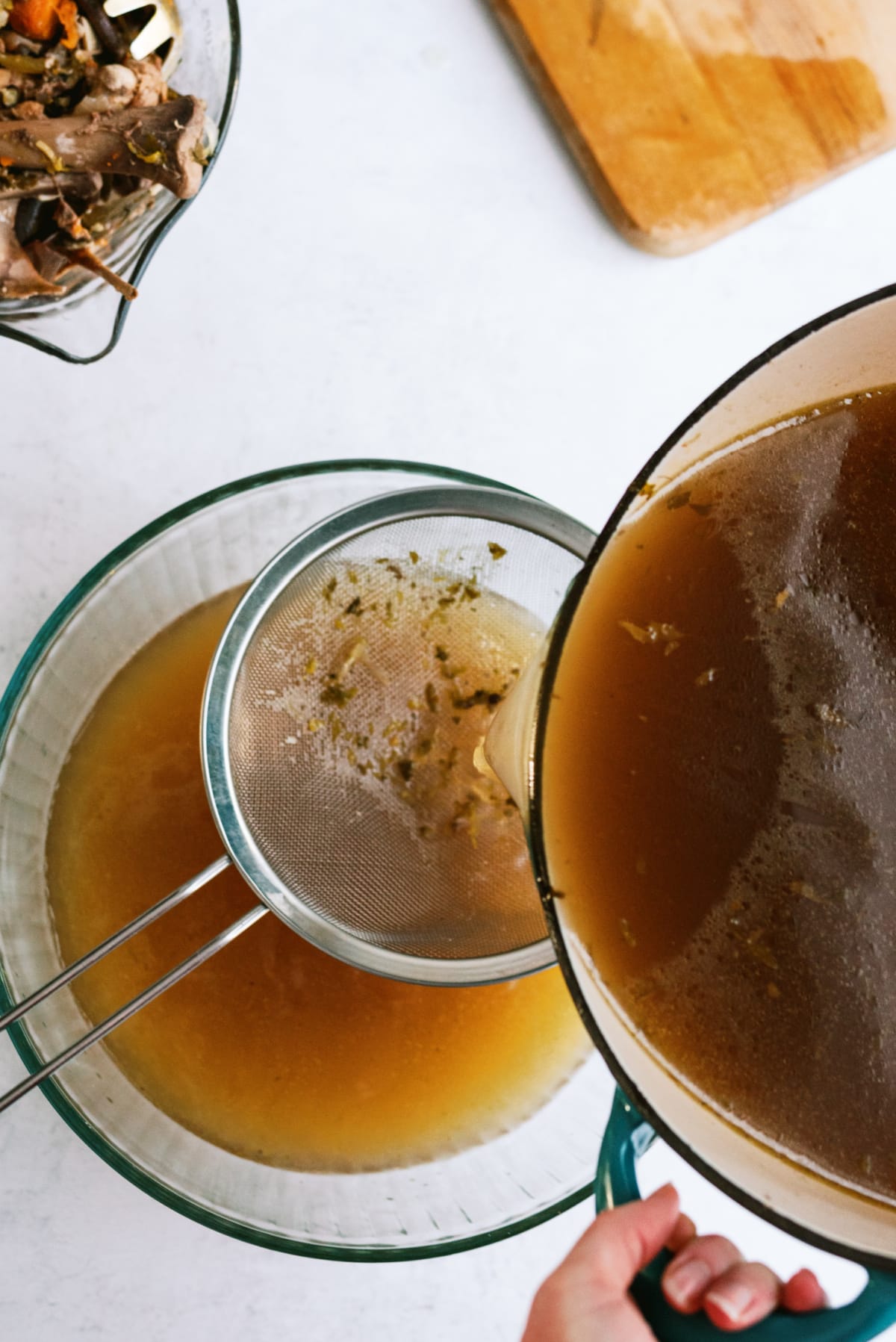
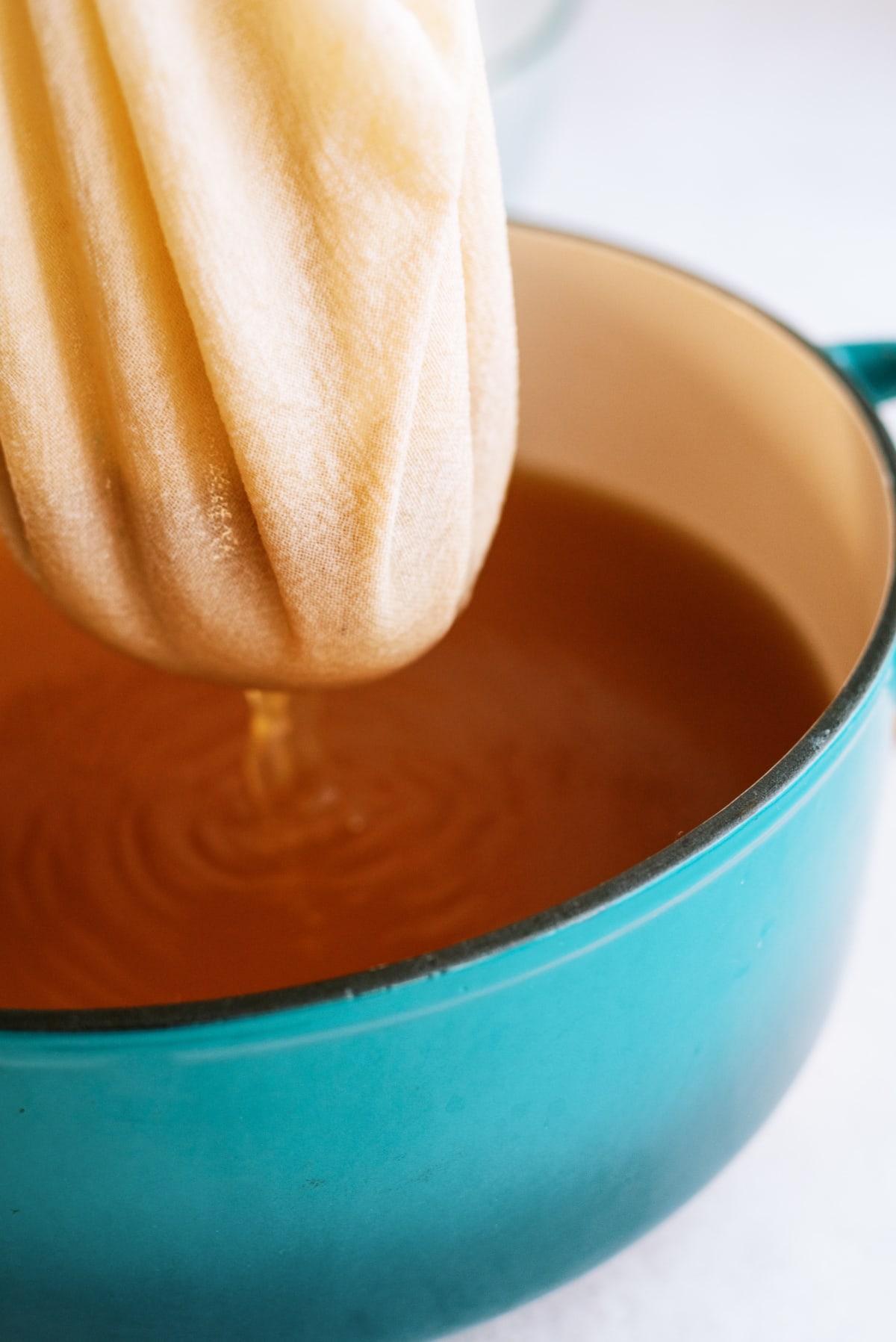
Store in Mason Jars + Refrigerate
Allow broth to cool a few minutes. Pour broth into mason jars or plastic quart containers, let sit out to bring to room temperature, then store in the refrigerator.
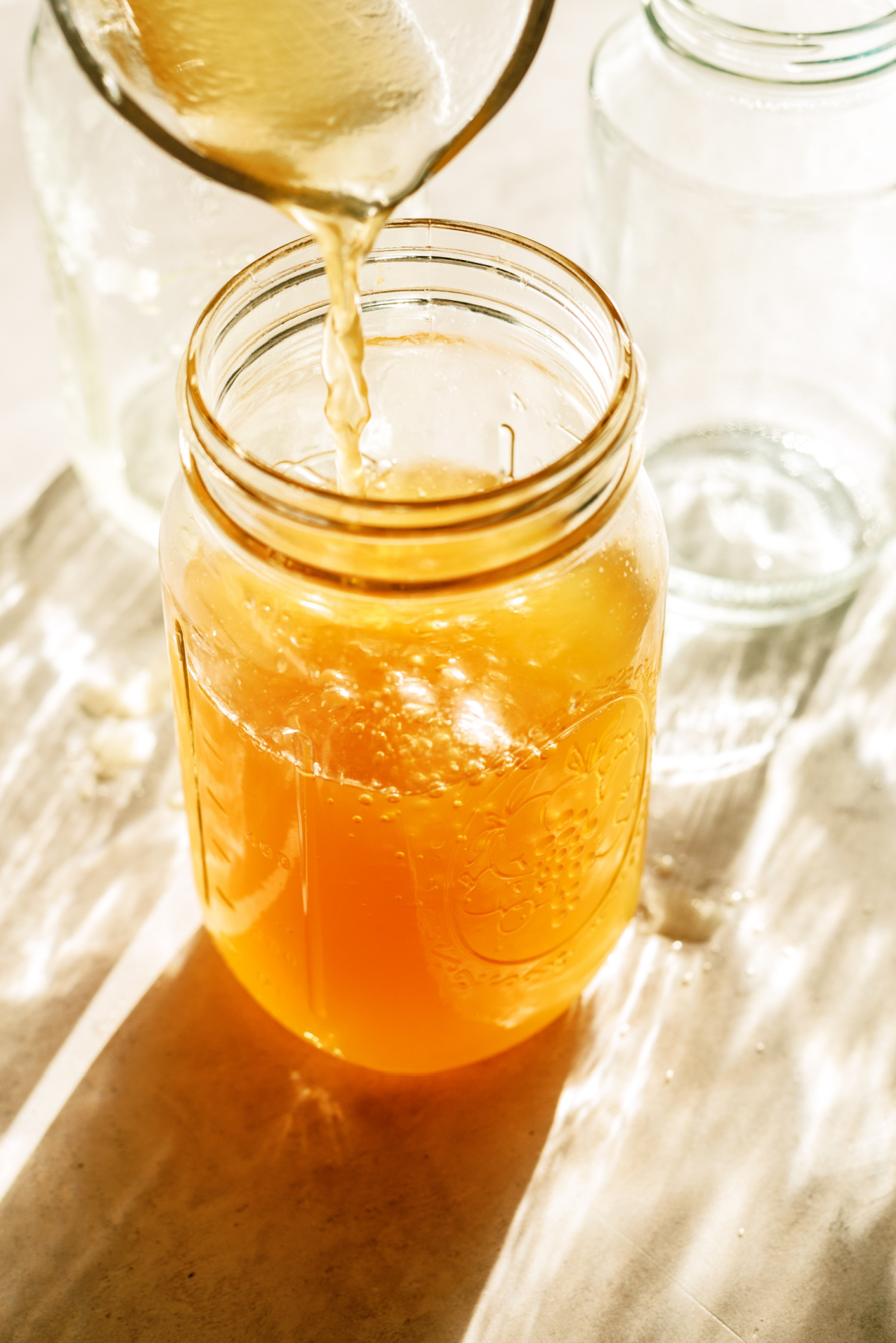
Ways to Use Bone Broth
Your nourishing homemade broth is now ready to enjoy! It can be used as a base for soups and stews, or sipped on its own as a wholesome and flavorful beverage. You can also add it to sauces, gravies, and other dishes in place of chicken stock (or beef stock) for an extra boost of flavor and nutrition.
Storing Bone Broth
After making your bone broth, allow it to cool slightly and then transfer it to containers and store in the refrigerator or freezer until ready to use. It can be stored in the refrigerator for up to 5 days or in the freezer for up to 6 months.
If you’re going to freeze your bone broth, make sure to use airtight, freezer safe plastic containers. Also make sure to leave some head space to allow for expansion.
Instant Pot + Slow Cooker Directions
I like to make bone broth on the stovetop, but I know others prefer to use their Instant Pot or Slow Cooker. I have included directions for those methods:
Instant Pot instructions:
- Preheat your oven to 425°F.
- Place the bones on a baking sheet and roast in the oven for 45 minutes, or until they are well browned.
- Transfer the roasted bones to the instant pot.
- Add the vinegar to the pot and let it sit for a few minutes to help extract the minerals from the bones.
- Add the vegetables, bay leaves, peppercorns, and enough water to cover the bones.
- Secure the lid on the instant pot and set it to the “soup” setting for 120 minutes.
- Once the cooking time is complete, allow the pressure to release naturally for at least 10 minutes before carefully releasing any remaining pressure.
- Strain the broth through a fine-mesh sieve and discard the solids.
- Allow the broth to cool slightly, then transfer it to containers and store in the refrigerator or freezer until ready to use.
Slow Cooker Instructions:
- Preheat your oven to 425°F.
- Place the bones on a baking sheet and roast in the oven for 45 minutes or until they are well browned.
- Transfer the roasted bones to the slow cooker.
- Add the vinegar to the pot and let it sit for a few minutes to help extract the minerals from the bones.
- Add the vegetables, bay leaves, peppercorns, and enough water to cover the bones.
- Secure the lid on the slow cooker and set it to the “low” setting for 12-24 hours.
- Strain the broth through a fine-mesh sieve and discard the solids.
- Allow the broth to cool slightly, then transfer it to containers and store in the refrigerator or freezer until ready to use.
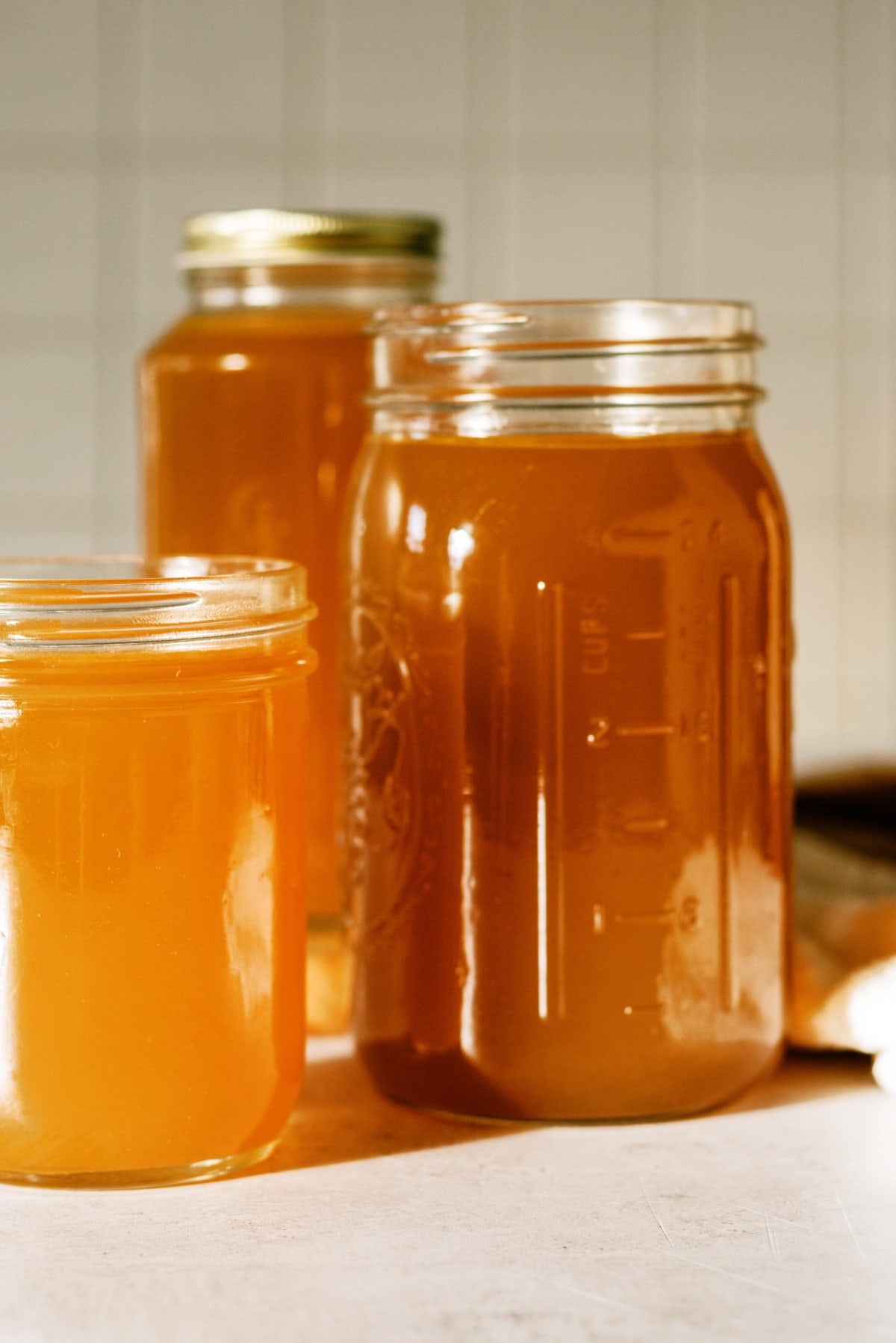
Recipes to try using bone broth!
- Chicken Pot Pie Soup
- Broccoli Cheese Soup
- Zuppa Toscana
- Cauliflower Soup (Instant Pot & Slow Cooker Directions)
I hope you give this recipe a try and enjoy the benefits of homemade bone broth. Let me know in the comments if you have any questions or tips for making the perfect bone broth.
The printable recipe card is below. Have a great day, friends! 🙂

Bone Broth Recipe
Ingredients
- bones chicken, turkey, beef, pork lamb, etc. (or chicken feet)
- onions including skins
- garlic including paper
- carrots
- celery
- parsley
- black peppercorns play this by ear (1-2 tbsp)
- 4-6 Bay Leaves
- 2 tbsp distilled vinegar
OR USE KITCHEN SCRAPS – keep in a zip bag in the freezer for up to 3 months then turn into bone broth
- Save all bones from dinners
- Save all scraps, onions, garlic, carrots, celery, parsley and other herbs from cooking
Instructions
- If bones are uncooked, place in a roasting pan with oil and roast on 425° F for 45 min, or until browned well
- If bones are already cooked, simply place in a large stock pot
- Add all vegetables, herbs/spices and vinegar to a pot and cover with water
- Bring to a boil, then reduce heat to a simmer
- Simmer on low for anywhere from 24-48 hours (this can also be done in a crockpot on low)
- Drain broth in a fine mesh strainer into a large bowl
- Drain broth again into another large bowl with a flour sack towel to strain out all the impurities
- Pour broth into mason jars or plastic quart containers and store in the refrigerator for up to 2 weeks
- Optional: Before pouring into mason jars, you can use a fat separator to strain out fat before storing in jars. The easiest way to strain extra fat though is to refrigerate and it will solidify at the top of the jar for easy removal. Use the fat for cooking!
- Freeze for up to 6 months in plastic containers.





Love your recipes Lauren.
The bone brotrecipe is great.
Thank you so much Kathy! Glad you enjoyed. It’s soooo good for you! 🙂
Thank you for this recipe, I had been hunting on how to make bone broth using lamb bones.
Carol, you’re so welcome! 🙂 Lamb broth sounds amazing!
Can this broth be canned?
Ruby, it sure can! However, keep in mind that the high heat may affect the gelatin factor and it will be quite liquid. Still delicious though!
I always wanted to try this
Terrell, once you do you’ll wonder why it took you so long to start! 🙂
Do you need to roast the bones or is it for added flavor?
Alice, roasting the bones is optional but yes – it adds a ton of great flavor!